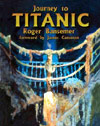|
| To Search This Site Enter Key Words Into Text Field On The Right and Hit The Search Button |
|
|
Roger Bansemer.
For more information about the author and his books, check out his website, www.Bansemer.com.
 |
Bansemer, Roger. Journey to Titanic. 1st printing. Sarasota: Pineapple Press, Inc. October, 2003. hardcover. foreword by James Cameron. illustrated by Roger Bansemer. isbn: 1561642924. scarcity: fairly common.
For the reader who would like to vicariously experience what it is like to accompany an expedition to the wreck of the Titanic, this book is going to be a pleasure in words and images. Bansemer’s art is wonderful, and he describes his trip in glorious artistic detail from beginning to end. Not many artists can be effective writers as well, and this artist/author is indeed both. He relates his journey in a pleasant, folksy style that is a comfortable, fun read.
Those of us who are serious students of the disaster, however, are likely to feel that the text does not live up to the quality of the images. Not because of any fault in style, but rather in content. Bansemer’s knowledge of the ship and the disaster is sketchy at best; something he freely acknowledges himself. As such, he wisely keeps information about the disaster to a bare minimum. Instead he focuses his words on his interpretations of his journey. The text of the book becomes, in essence, a travelogue.
If you saw James Cameron’s Ghosts of the Abyss 3-D film you are aware of actor Bill Paxton’s gee-whiz, everyman’s reaction to the dive. Some people really enjoyed experiencing the journey through Paxton’s eyes. Others found his inclusion pointless and annoying, taking film time away from the real star of the show. Bansemer’s book feels very similar. If you loved the common man’s insights that Paxton brought to the film, you will equally enjoy Bansemer’s view of his expedition. If Paxton just annoyed the heck out of you, you may find the text of this book a letdown.
Another way that the book may be a disappointment for some readers is that the amount of the text and art dedicated to Titanic herself is rather limited. It does take a long time to get to the meat of the story. Bansemer’s dive to the wreck does not begin until page 71, and the book is only 128 pages long. Once on the bottom, there are only about 24 pages of art devoted to the wreck itself. Following the chapter about his dive, there is a follow-up chapter which includes his artistic interpretation of items brought up from the bottom. Bansemer was a participant of the last RMS Titanic Inc. dive in 2000, whose primarily purpose was artifact recovery.
Your enjoyment of this book depends on your understanding of what you are, versus what you are not getting. As a book about the Titanic, this work is weak. Very weak. But if you would like to learn what it is like to join an expedition to the wreck, sail with the crew, meet the people on board, and experience a dive to the most famous of shipwrecks, this book delivers that journey in superb style.
Roger Bansemer has painted the sea, its people, its ships, its shores, its lighthouses all his life. After graduation from the Ringling School of Art and Design and a stint in the Navy, he built a unique home and studio/gallery in Clearwater, Florida, where he paints and displays his art. He has seven other books in print: The Art of Hot-Air Ballooning, At Water’s Edge, Mountains in the Mist, Rachael’s Splendifilous Adventure, Bansemer’s Book of Florida Lighthouses, Bansemer’s Book of Carolina and Georgia Lighthouses and Bansemer’s Book of the Southern Shores.
|
|
Bansemer, Roger. Journey to Titanic. 1st softcover printing. Sarasota: Pineapple Press, Inc. October, 2003. wraps. isbn: 1561642932. scarcity: fairly common. This version has the same cover illustration as the hardcover edition.
|
|
|
|
|